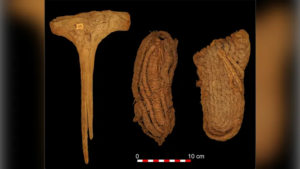‘Prehistoric footwear’ was discovered in Spanish cave by miners, scientists reveal in new study
What may have been the oldest pair of shoes in Europe were discovered in a cave in Spain and are now thought to be much older than scientists previously thought.About 20 pairs of the sandals are at least 6,200 years old — and possibly older — while other woven objects in the cave are dated back 9,500 years, according to a new study by scientists.

The news emerged after scientists used carbon-dating on 76 objects from the Cueva de los Murciélagos, Albuñol, near Granada, that had been dug out by miners in the 19th century.Among the objects are baskets representing the first direct evidence of the skill in Mesolithic hunter-gatherer societies in Southern Europe.
The objects, made of wood, reed and esparto grass, date to the early and middle Holocene period, between 9,500 and 6,200 years ago, the scientists said.The study about the finds from the Universidad de Alcalá (UAH) and the Universitat Autònoma de Barcelona (UAB) was published in the journal Science Advances.
Said Francisco Martínez Sevilla, a researcher at the Prehistory Department of UAH, “These are the earliest and widest-ranging assemblage of prehistoric footwear, both in the Iberian Peninsula and in Europe, unparalleled at other latitudes,” as SWNS, the British news service, reported.
“The new dating of the esparto baskets from the Cueva de los Murciélagos of Albuñol opens a window of opportunity to understanding the last hunter-gatherer societies of the early Holocene.”He added, “The quality and technological complexity of the basketry makes us question the simplistic assumptions we have about human communities prior to the arrival of agriculture in Southern Europe.”
He said the work and the project that’s being developed “[place] the Cueva de los Murciélagos as a unique site in Europe to study the organic materials of prehistoric populations.”Cueva de los Murciélagos, or “Cave of the Bats,” is located on the coast of Granada, to the south of the Sierra Nevada.
It is believed the finds were well-preserved, thanks to the low humidity levels of the area.The bat cave opens on the right side of the Barranco de las Angosturas, at an altitude of 450 meters above sea level and about seven kilometers from the current coastline.
It is one of the most emblematic prehistoric archeological sites of the Iberian Peninsula due to the rare preservation of organic materials, SWNS also said.Study co-author María Herrero Otal said, “The esparto grass objects from Cueva de los Murciélagos are the oldest and best-preserved set of plant fibre materials in Southern Europe so far known,” as SWNS also noted.

